Data Analysis: Techniques and Measures
VerifiedAdded on 2023/01/11
|9
|1328
|33
AI Summary
This report explores data analysis techniques and measures such as mean, mode, median, standard deviation, and linear forecasting model. It discusses how to present data in tables and charts.
Contribute Materials
Your contribution can guide someone’s learning journey. Share your
documents today.
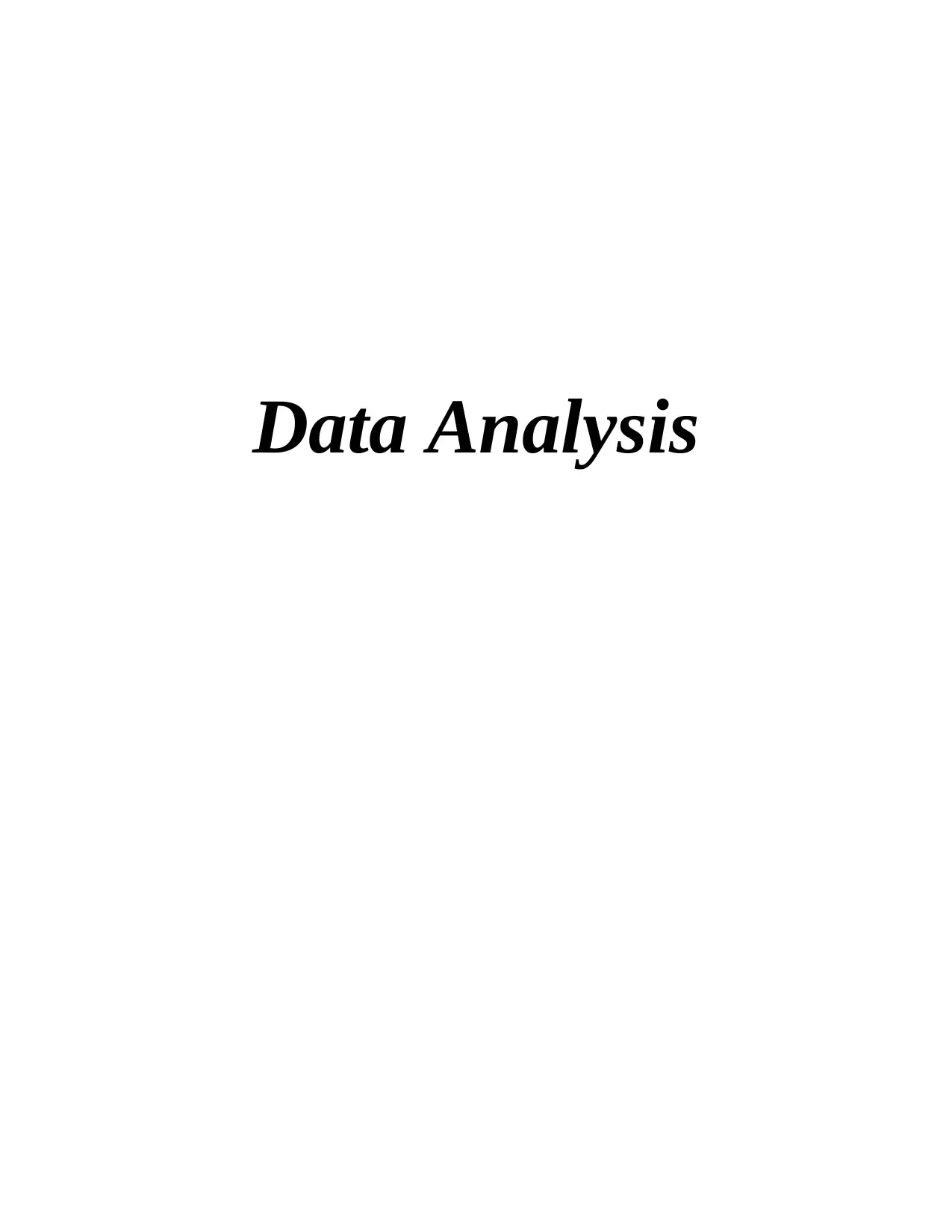
Data Analysis
Secure Best Marks with AI Grader
Need help grading? Try our AI Grader for instant feedback on your assignments.
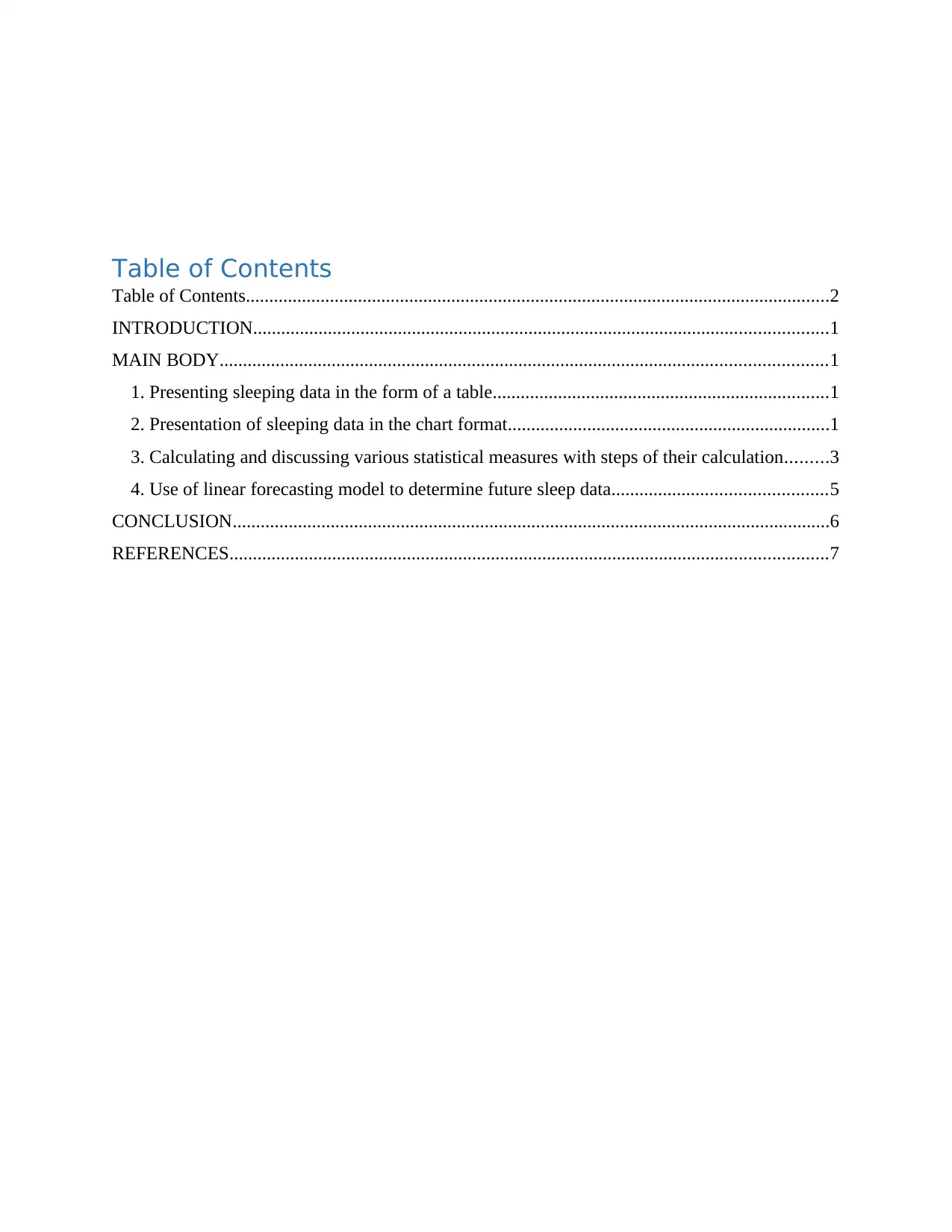
Table of Contents
Table of Contents.............................................................................................................................2
INTRODUCTION...........................................................................................................................1
MAIN BODY..................................................................................................................................1
1. Presenting sleeping data in the form of a table........................................................................1
2. Presentation of sleeping data in the chart format.....................................................................1
3. Calculating and discussing various statistical measures with steps of their calculation.........3
4. Use of linear forecasting model to determine future sleep data..............................................5
CONCLUSION................................................................................................................................6
REFERENCES................................................................................................................................7
Table of Contents.............................................................................................................................2
INTRODUCTION...........................................................................................................................1
MAIN BODY..................................................................................................................................1
1. Presenting sleeping data in the form of a table........................................................................1
2. Presentation of sleeping data in the chart format.....................................................................1
3. Calculating and discussing various statistical measures with steps of their calculation.........3
4. Use of linear forecasting model to determine future sleep data..............................................5
CONCLUSION................................................................................................................................6
REFERENCES................................................................................................................................7
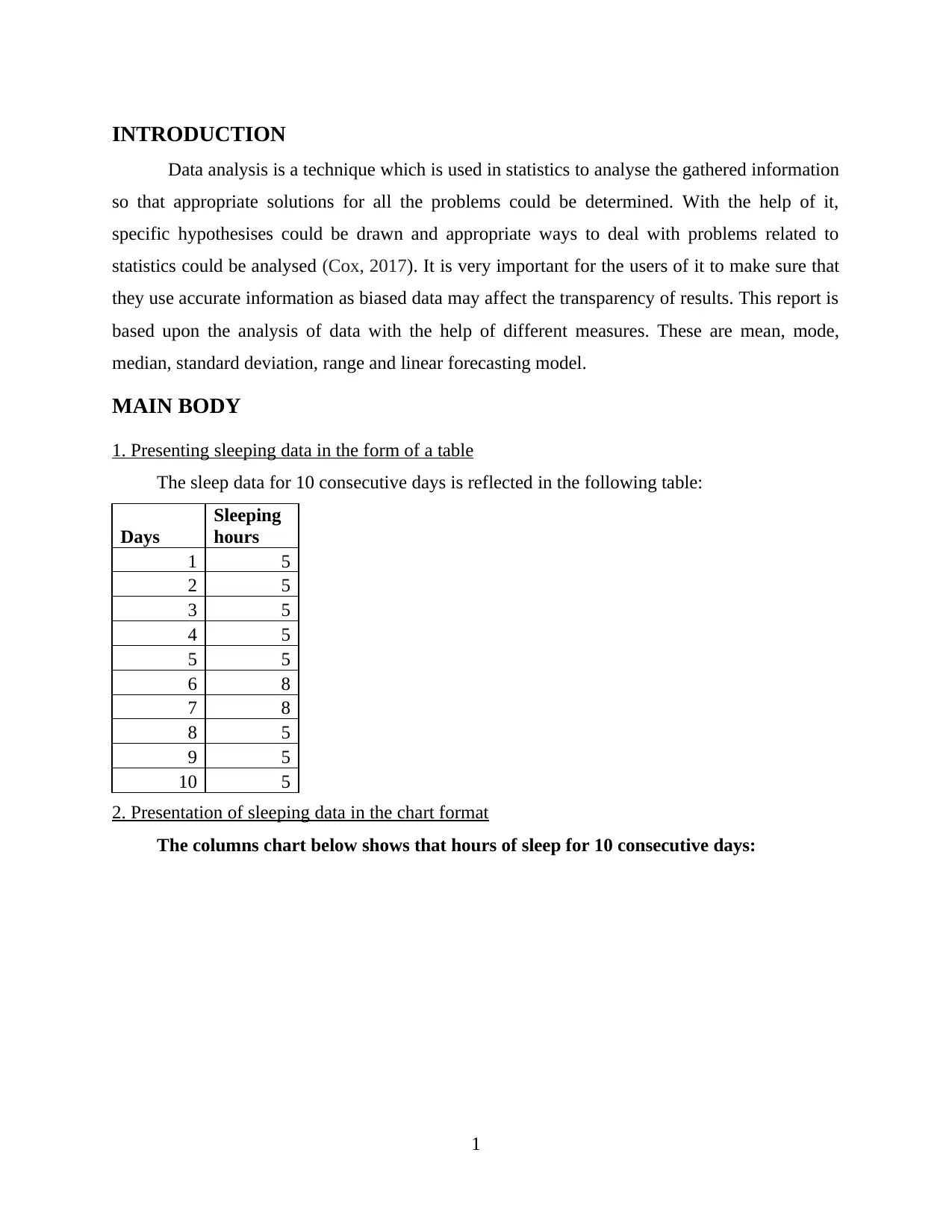
INTRODUCTION
Data analysis is a technique which is used in statistics to analyse the gathered information
so that appropriate solutions for all the problems could be determined. With the help of it,
specific hypothesises could be drawn and appropriate ways to deal with problems related to
statistics could be analysed (Cox, 2017). It is very important for the users of it to make sure that
they use accurate information as biased data may affect the transparency of results. This report is
based upon the analysis of data with the help of different measures. These are mean, mode,
median, standard deviation, range and linear forecasting model.
MAIN BODY
1. Presenting sleeping data in the form of a table
The sleep data for 10 consecutive days is reflected in the following table:
Days
Sleeping
hours
1 5
2 5
3 5
4 5
5 5
6 8
7 8
8 5
9 5
10 5
2. Presentation of sleeping data in the chart format
The columns chart below shows that hours of sleep for 10 consecutive days:
1
Data analysis is a technique which is used in statistics to analyse the gathered information
so that appropriate solutions for all the problems could be determined. With the help of it,
specific hypothesises could be drawn and appropriate ways to deal with problems related to
statistics could be analysed (Cox, 2017). It is very important for the users of it to make sure that
they use accurate information as biased data may affect the transparency of results. This report is
based upon the analysis of data with the help of different measures. These are mean, mode,
median, standard deviation, range and linear forecasting model.
MAIN BODY
1. Presenting sleeping data in the form of a table
The sleep data for 10 consecutive days is reflected in the following table:
Days
Sleeping
hours
1 5
2 5
3 5
4 5
5 5
6 8
7 8
8 5
9 5
10 5
2. Presentation of sleeping data in the chart format
The columns chart below shows that hours of sleep for 10 consecutive days:
1
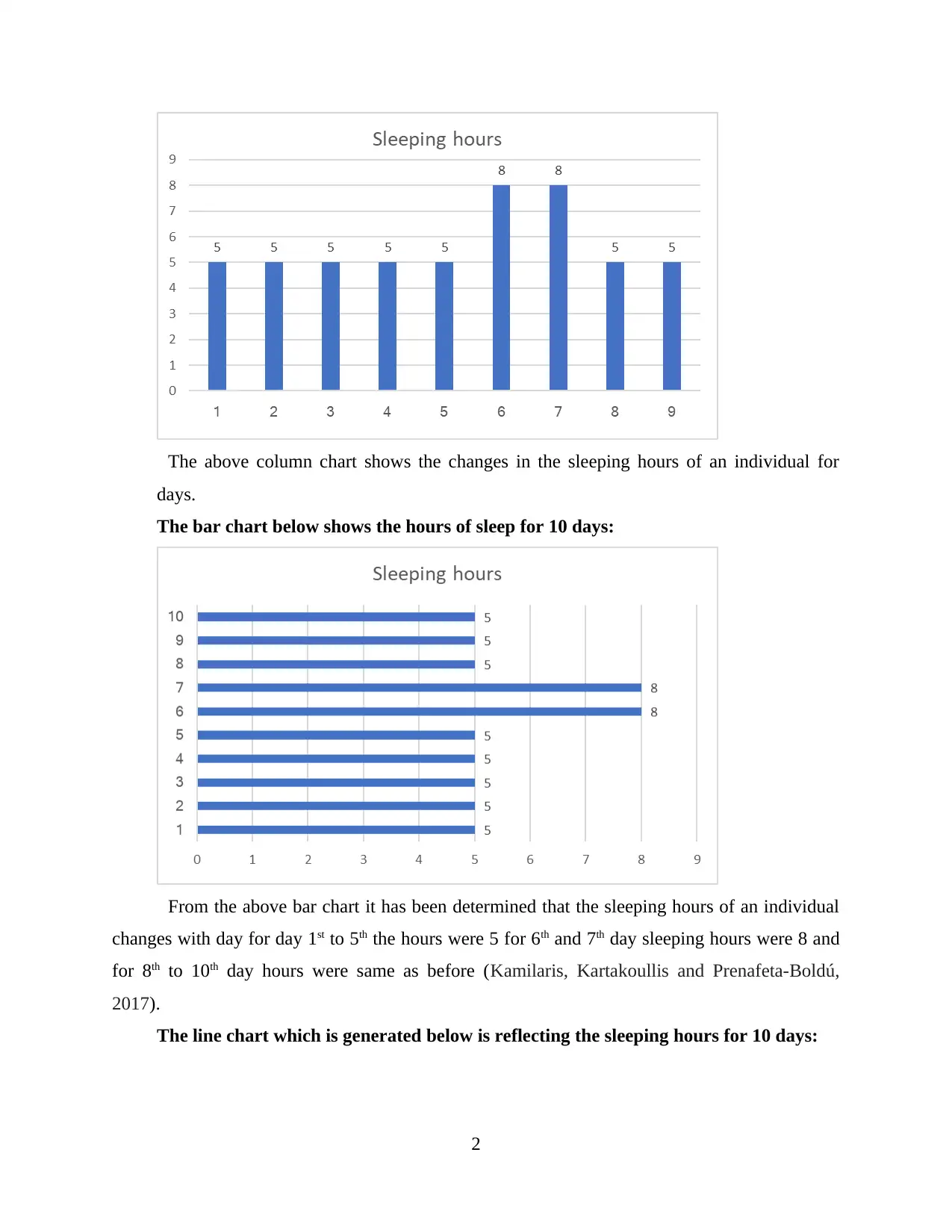
The above column chart shows the changes in the sleeping hours of an individual for
days.
The bar chart below shows the hours of sleep for 10 days:
From the above bar chart it has been determined that the sleeping hours of an individual
changes with day for day 1st to 5th the hours were 5 for 6th and 7th day sleeping hours were 8 and
for 8th to 10th day hours were same as before (Kamilaris, Kartakoullis and Prenafeta-Boldú,
2017).
The line chart which is generated below is reflecting the sleeping hours for 10 days:
2
days.
The bar chart below shows the hours of sleep for 10 days:
From the above bar chart it has been determined that the sleeping hours of an individual
changes with day for day 1st to 5th the hours were 5 for 6th and 7th day sleeping hours were 8 and
for 8th to 10th day hours were same as before (Kamilaris, Kartakoullis and Prenafeta-Boldú,
2017).
The line chart which is generated below is reflecting the sleeping hours for 10 days:
2
Secure Best Marks with AI Grader
Need help grading? Try our AI Grader for instant feedback on your assignments.
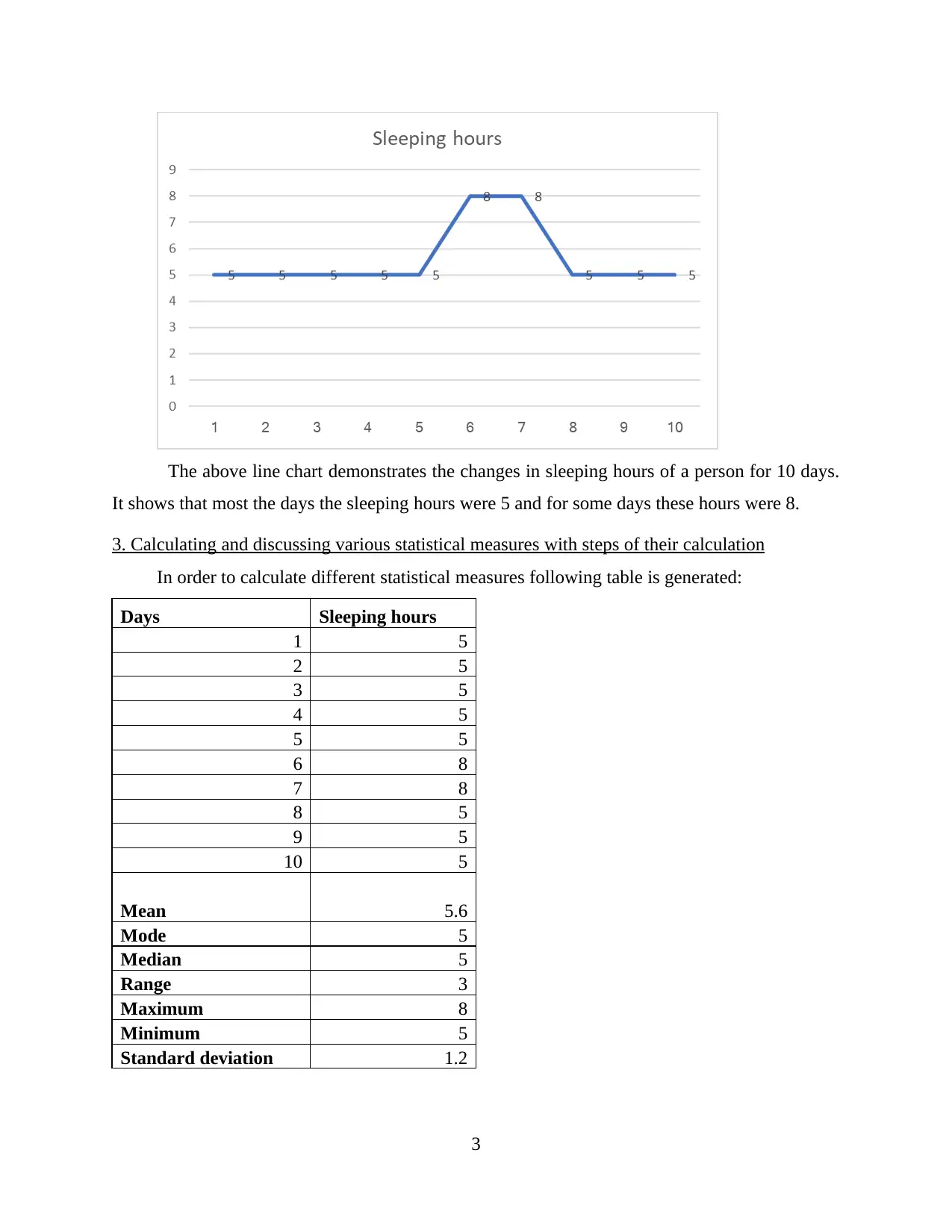
The above line chart demonstrates the changes in sleeping hours of a person for 10 days.
It shows that most the days the sleeping hours were 5 and for some days these hours were 8.
3. Calculating and discussing various statistical measures with steps of their calculation
In order to calculate different statistical measures following table is generated:
Days Sleeping hours
1 5
2 5
3 5
4 5
5 5
6 8
7 8
8 5
9 5
10 5
Mean 5.6
Mode 5
Median 5
Range 3
Maximum 8
Minimum 5
Standard deviation 1.2
3
It shows that most the days the sleeping hours were 5 and for some days these hours were 8.
3. Calculating and discussing various statistical measures with steps of their calculation
In order to calculate different statistical measures following table is generated:
Days Sleeping hours
1 5
2 5
3 5
4 5
5 5
6 8
7 8
8 5
9 5
10 5
Mean 5.6
Mode 5
Median 5
Range 3
Maximum 8
Minimum 5
Standard deviation 1.2
3
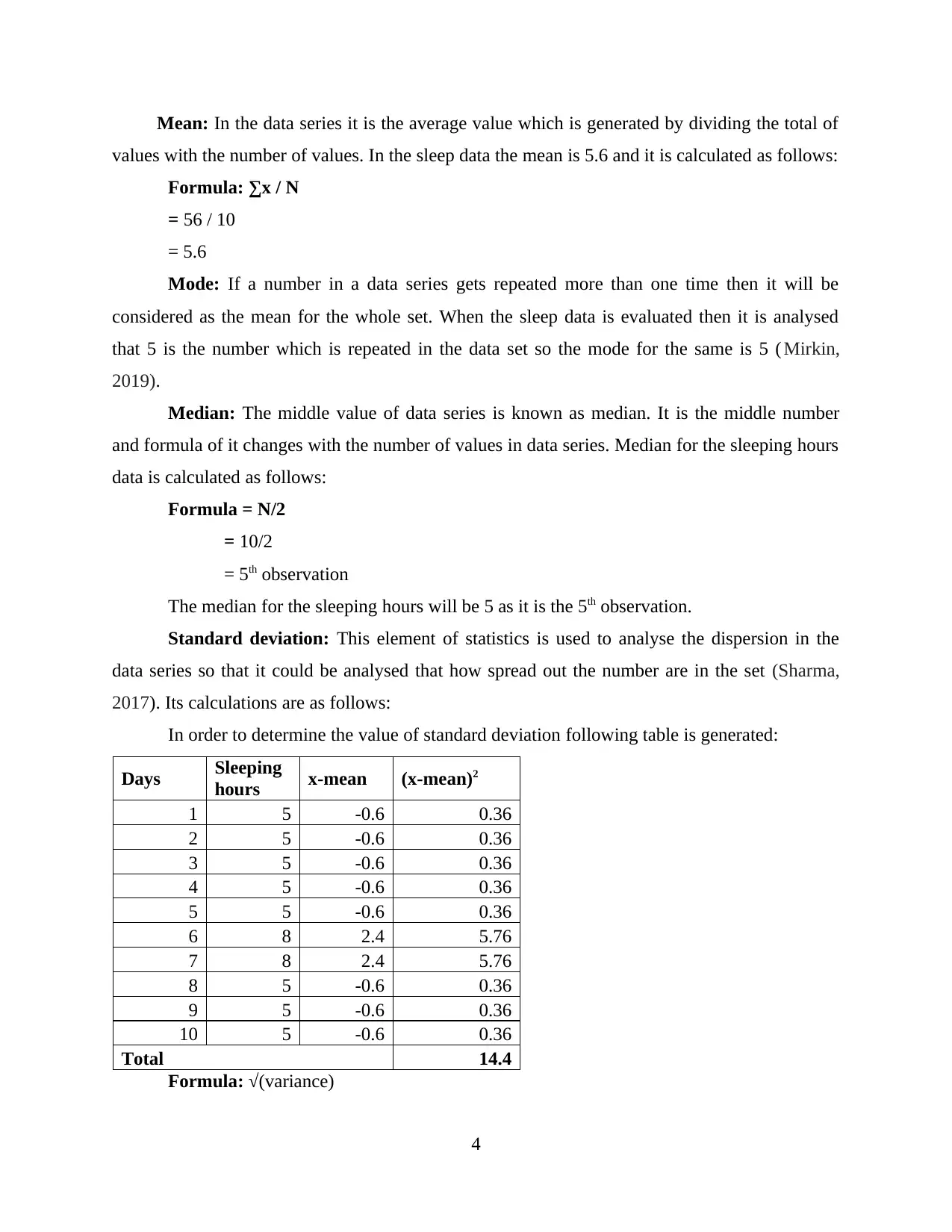
Mean: In the data series it is the average value which is generated by dividing the total of
values with the number of values. In the sleep data the mean is 5.6 and it is calculated as follows:
Formula: ∑x / N
= 56 / 10
= 5.6
Mode: If a number in a data series gets repeated more than one time then it will be
considered as the mean for the whole set. When the sleep data is evaluated then it is analysed
that 5 is the number which is repeated in the data set so the mode for the same is 5 ( Mirkin,
2019).
Median: The middle value of data series is known as median. It is the middle number
and formula of it changes with the number of values in data series. Median for the sleeping hours
data is calculated as follows:
Formula = N/2
= 10/2
= 5th observation
The median for the sleeping hours will be 5 as it is the 5th observation.
Standard deviation: This element of statistics is used to analyse the dispersion in the
data series so that it could be analysed that how spread out the number are in the set (Sharma,
2017). Its calculations are as follows:
In order to determine the value of standard deviation following table is generated:
Days Sleeping
hours x-mean (x-mean)2
1 5 -0.6 0.36
2 5 -0.6 0.36
3 5 -0.6 0.36
4 5 -0.6 0.36
5 5 -0.6 0.36
6 8 2.4 5.76
7 8 2.4 5.76
8 5 -0.6 0.36
9 5 -0.6 0.36
10 5 -0.6 0.36
Total 14.4
Formula: √(variance)
4
values with the number of values. In the sleep data the mean is 5.6 and it is calculated as follows:
Formula: ∑x / N
= 56 / 10
= 5.6
Mode: If a number in a data series gets repeated more than one time then it will be
considered as the mean for the whole set. When the sleep data is evaluated then it is analysed
that 5 is the number which is repeated in the data set so the mode for the same is 5 ( Mirkin,
2019).
Median: The middle value of data series is known as median. It is the middle number
and formula of it changes with the number of values in data series. Median for the sleeping hours
data is calculated as follows:
Formula = N/2
= 10/2
= 5th observation
The median for the sleeping hours will be 5 as it is the 5th observation.
Standard deviation: This element of statistics is used to analyse the dispersion in the
data series so that it could be analysed that how spread out the number are in the set (Sharma,
2017). Its calculations are as follows:
In order to determine the value of standard deviation following table is generated:
Days Sleeping
hours x-mean (x-mean)2
1 5 -0.6 0.36
2 5 -0.6 0.36
3 5 -0.6 0.36
4 5 -0.6 0.36
5 5 -0.6 0.36
6 8 2.4 5.76
7 8 2.4 5.76
8 5 -0.6 0.36
9 5 -0.6 0.36
10 5 -0.6 0.36
Total 14.4
Formula: √(variance)
4
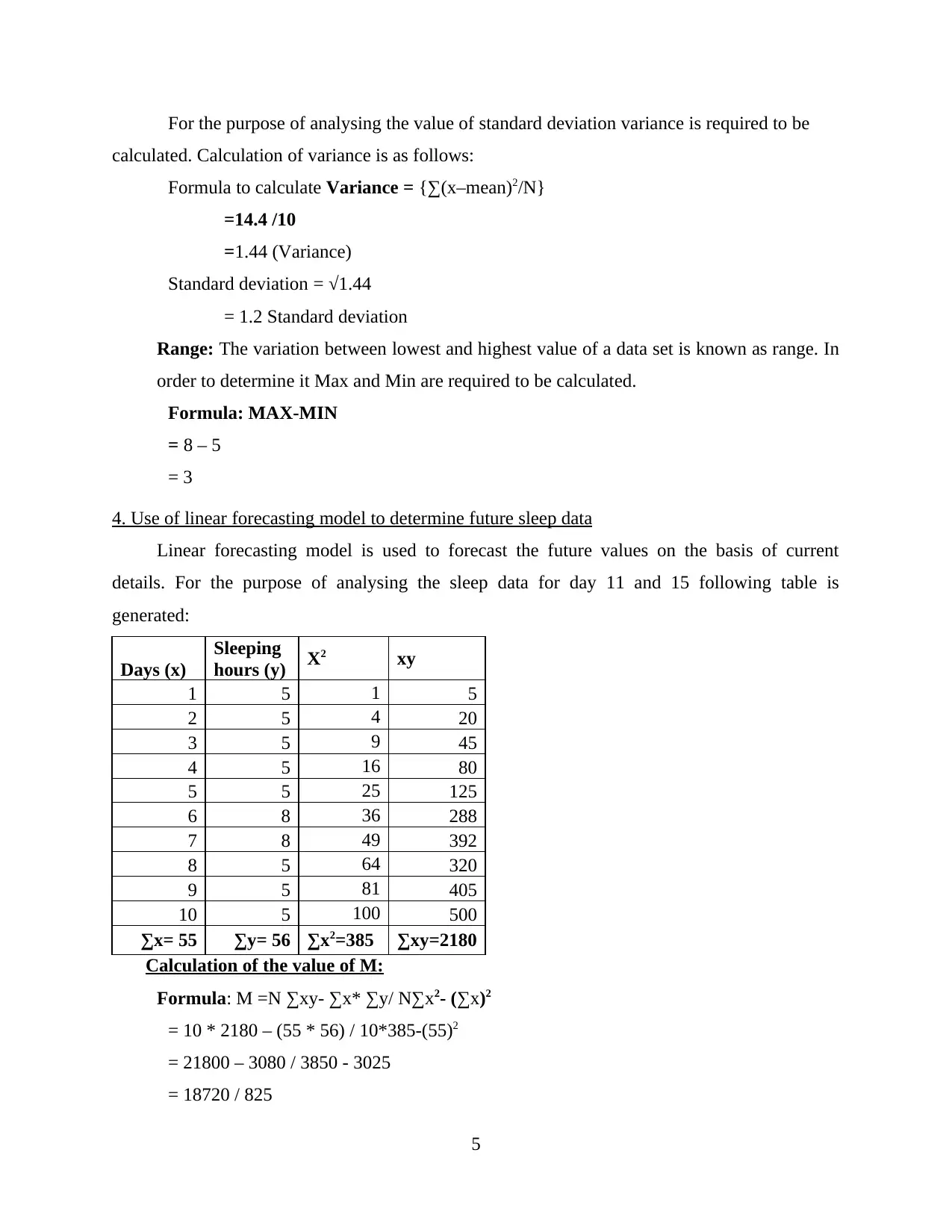
For the purpose of analysing the value of standard deviation variance is required to be
calculated. Calculation of variance is as follows:
Formula to calculate Variance = {∑(x–mean)2/N}
=14.4 /10
=1.44 (Variance)
Standard deviation = √1.44
= 1.2 Standard deviation
Range: The variation between lowest and highest value of a data set is known as range. In
order to determine it Max and Min are required to be calculated.
Formula: MAX-MIN
= 8 – 5
= 3
4. Use of linear forecasting model to determine future sleep data
Linear forecasting model is used to forecast the future values on the basis of current
details. For the purpose of analysing the sleep data for day 11 and 15 following table is
generated:
Days (x)
Sleeping
hours (y) X2 xy
1 5 1 5
2 5 4 20
3 5 9 45
4 5 16 80
5 5 25 125
6 8 36 288
7 8 49 392
8 5 64 320
9 5 81 405
10 5 100 500
∑x= 55 ∑y= 56 ∑x2=385 ∑xy=2180
Calculation of the value of M:
Formula: M =N ∑xy- ∑x* ∑y/ N∑x2- (∑x)2
= 10 * 2180 – (55 * 56) / 10*385-(55)2
= 21800 – 3080 / 3850 - 3025
= 18720 / 825
5
calculated. Calculation of variance is as follows:
Formula to calculate Variance = {∑(x–mean)2/N}
=14.4 /10
=1.44 (Variance)
Standard deviation = √1.44
= 1.2 Standard deviation
Range: The variation between lowest and highest value of a data set is known as range. In
order to determine it Max and Min are required to be calculated.
Formula: MAX-MIN
= 8 – 5
= 3
4. Use of linear forecasting model to determine future sleep data
Linear forecasting model is used to forecast the future values on the basis of current
details. For the purpose of analysing the sleep data for day 11 and 15 following table is
generated:
Days (x)
Sleeping
hours (y) X2 xy
1 5 1 5
2 5 4 20
3 5 9 45
4 5 16 80
5 5 25 125
6 8 36 288
7 8 49 392
8 5 64 320
9 5 81 405
10 5 100 500
∑x= 55 ∑y= 56 ∑x2=385 ∑xy=2180
Calculation of the value of M:
Formula: M =N ∑xy- ∑x* ∑y/ N∑x2- (∑x)2
= 10 * 2180 – (55 * 56) / 10*385-(55)2
= 21800 – 3080 / 3850 - 3025
= 18720 / 825
5
Paraphrase This Document
Need a fresh take? Get an instant paraphrase of this document with our AI Paraphraser
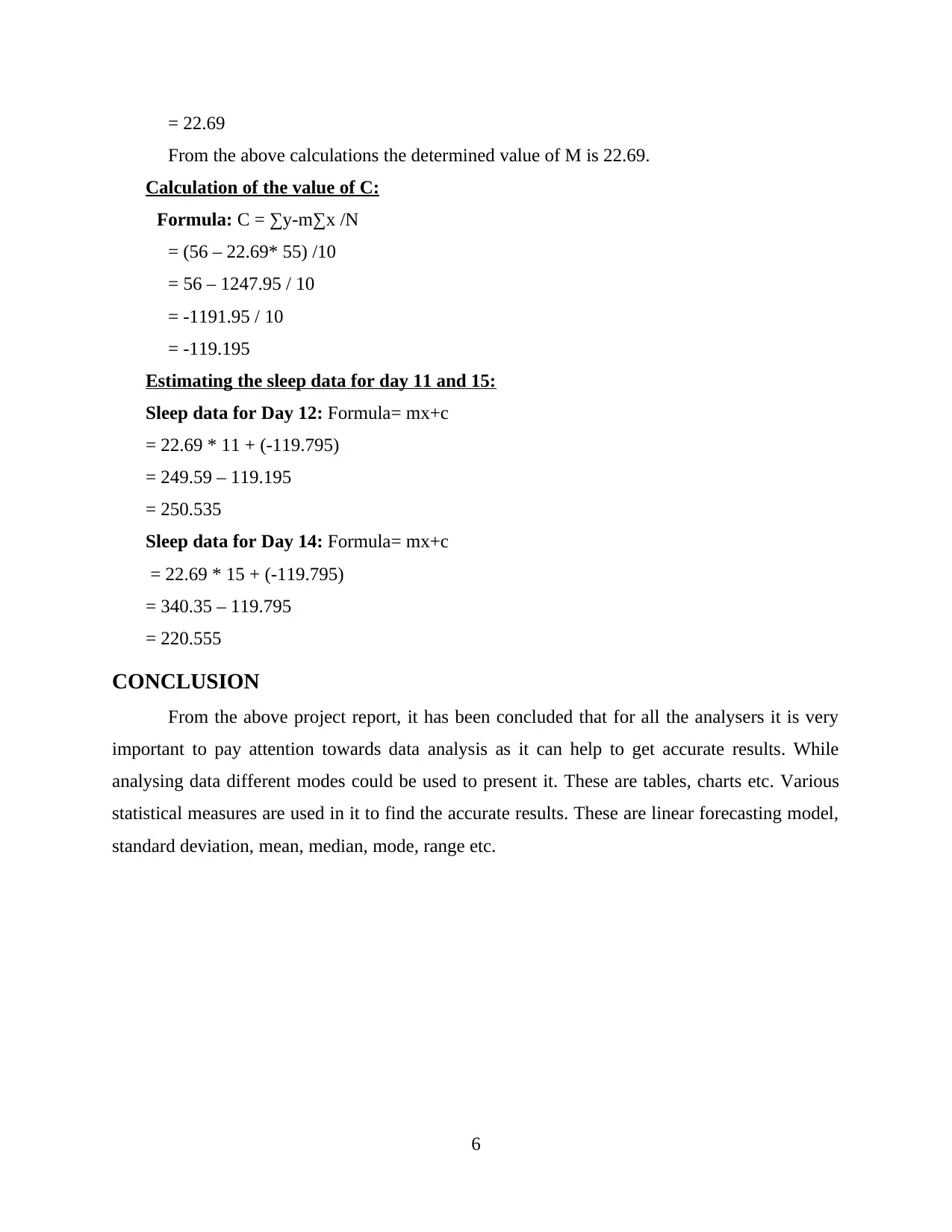
= 22.69
From the above calculations the determined value of M is 22.69.
Calculation of the value of C:
Formula: C = ∑y-m∑x /N
= (56 – 22.69* 55) /10
= 56 – 1247.95 / 10
= -1191.95 / 10
= -119.195
Estimating the sleep data for day 11 and 15:
Sleep data for Day 12: Formula= mx+c
= 22.69 * 11 + (-119.795)
= 249.59 – 119.195
= 250.535
Sleep data for Day 14: Formula= mx+c
= 22.69 * 15 + (-119.795)
= 340.35 – 119.795
= 220.555
CONCLUSION
From the above project report, it has been concluded that for all the analysers it is very
important to pay attention towards data analysis as it can help to get accurate results. While
analysing data different modes could be used to present it. These are tables, charts etc. Various
statistical measures are used in it to find the accurate results. These are linear forecasting model,
standard deviation, mean, median, mode, range etc.
6
From the above calculations the determined value of M is 22.69.
Calculation of the value of C:
Formula: C = ∑y-m∑x /N
= (56 – 22.69* 55) /10
= 56 – 1247.95 / 10
= -1191.95 / 10
= -119.195
Estimating the sleep data for day 11 and 15:
Sleep data for Day 12: Formula= mx+c
= 22.69 * 11 + (-119.795)
= 249.59 – 119.195
= 250.535
Sleep data for Day 14: Formula= mx+c
= 22.69 * 15 + (-119.795)
= 340.35 – 119.795
= 220.555
CONCLUSION
From the above project report, it has been concluded that for all the analysers it is very
important to pay attention towards data analysis as it can help to get accurate results. While
analysing data different modes could be used to present it. These are tables, charts etc. Various
statistical measures are used in it to find the accurate results. These are linear forecasting model,
standard deviation, mean, median, mode, range etc.
6
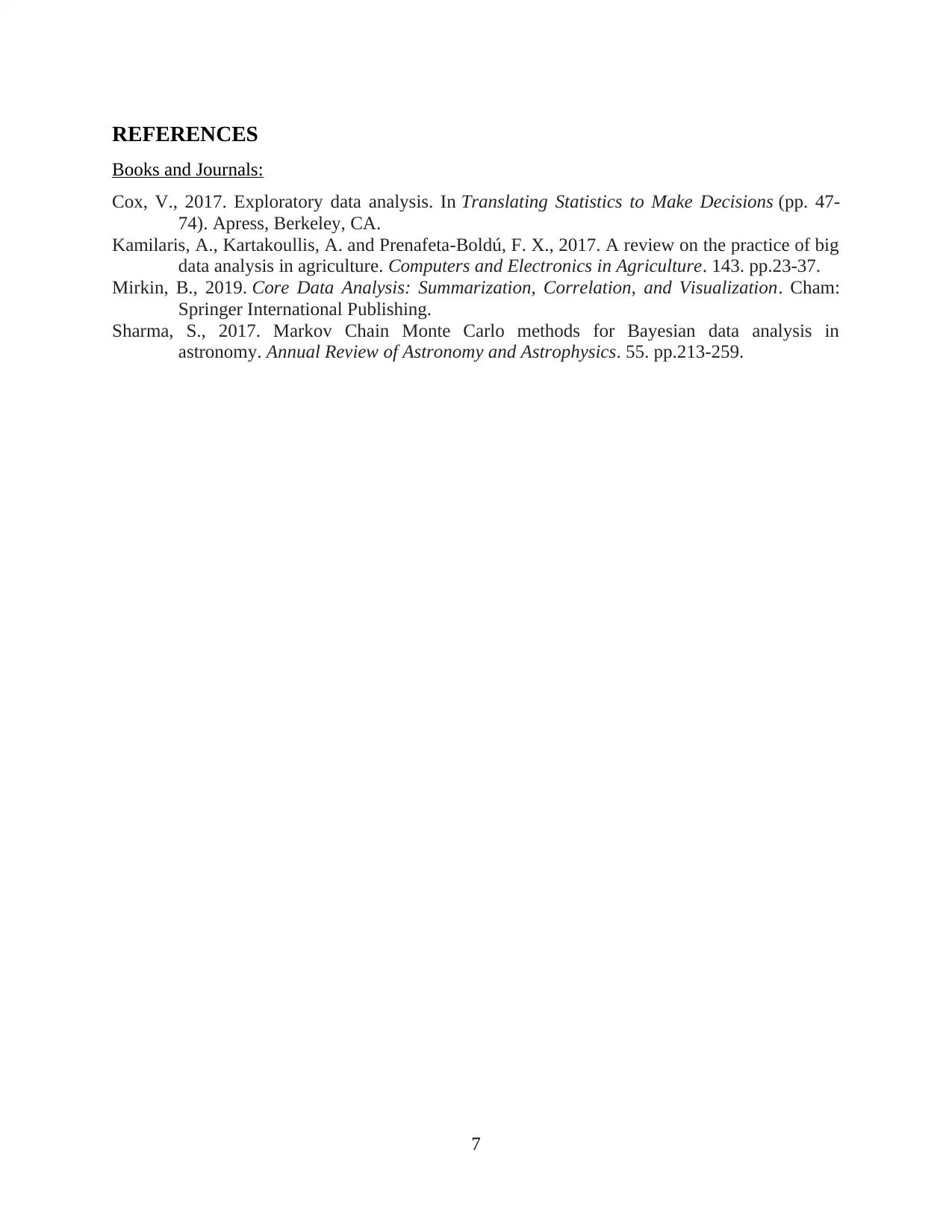
REFERENCES
Books and Journals:
Cox, V., 2017. Exploratory data analysis. In Translating Statistics to Make Decisions (pp. 47-
74). Apress, Berkeley, CA.
Kamilaris, A., Kartakoullis, A. and Prenafeta-Boldú, F. X., 2017. A review on the practice of big
data analysis in agriculture. Computers and Electronics in Agriculture. 143. pp.23-37.
Mirkin, B., 2019. Core Data Analysis: Summarization, Correlation, and Visualization. Cham:
Springer International Publishing.
Sharma, S., 2017. Markov Chain Monte Carlo methods for Bayesian data analysis in
astronomy. Annual Review of Astronomy and Astrophysics. 55. pp.213-259.
7
Books and Journals:
Cox, V., 2017. Exploratory data analysis. In Translating Statistics to Make Decisions (pp. 47-
74). Apress, Berkeley, CA.
Kamilaris, A., Kartakoullis, A. and Prenafeta-Boldú, F. X., 2017. A review on the practice of big
data analysis in agriculture. Computers and Electronics in Agriculture. 143. pp.23-37.
Mirkin, B., 2019. Core Data Analysis: Summarization, Correlation, and Visualization. Cham:
Springer International Publishing.
Sharma, S., 2017. Markov Chain Monte Carlo methods for Bayesian data analysis in
astronomy. Annual Review of Astronomy and Astrophysics. 55. pp.213-259.
7
1 out of 9
Related Documents
Your All-in-One AI-Powered Toolkit for Academic Success.
+13062052269
info@desklib.com
Available 24*7 on WhatsApp / Email
![[object Object]](/_next/static/media/star-bottom.7253800d.svg)
Unlock your academic potential
© 2024 | Zucol Services PVT LTD | All rights reserved.





